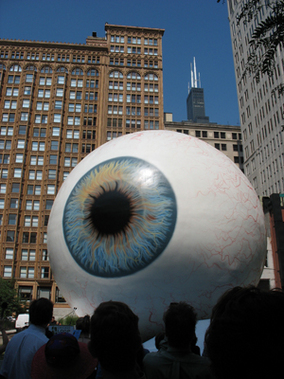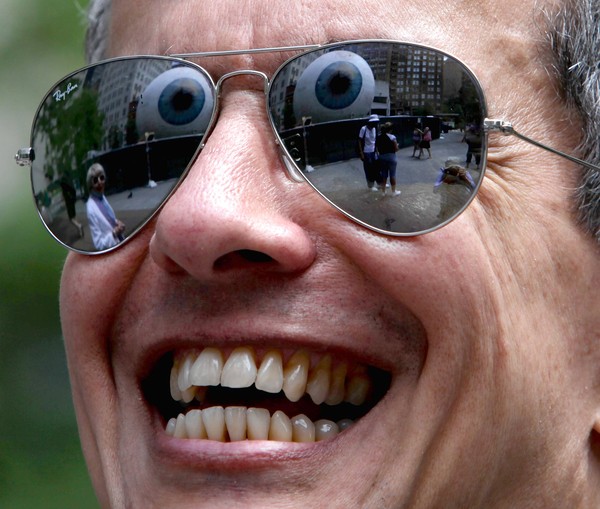Chicago’s latest public artwork of note is titled Eye. The artist, TonyTasset, apparently likes to say what he means.

The thirty foot high eyeball has been placed in Pritzker Park and is getting a good deal of attention. (The full installation is entitled Eye and Cardinal, but I haven’t heard a thing about the bird.) One reason will be that it invites comparison with The Bean, a large, reflective object in Millennium Park otherwise known as Cloud Gate, by Anish Kapoor. Both sculptures are examples of the role of spectatorship in the self-understanding of the modern city.
Imagine a large sculpture of a human ear. Or nose, or lips. Or perhaps a giant foot. Not likely, although the urban environment certainly requires walking, and civic life is very much about talking and listening, and about smelling (sometimes to our dismay). I can’t say that some artist won’t sell some city manager on the idea of branching out, but these figures still would not challenge the role of seeing as an organizing principle of modern society. What artworks such as the Bean and Eye do is deflect our attention from the objects of sight to the process itself, which is a social process: we see ourselves reflected amidst those strangers milling casually around us, and we see the organ of sight itself as a public monument—as a monument to being together in public.
Nor are these works unique. Think of all the observation decks, sightseeing buses, and other modes of spectatorship that are fixtures of urban tourism. Note other artists who highlight urban optics, such as the Eye Walkers (my label) created by Medaman-Medaman. These are but a very few of the many ways that urban culture is a distinctive kind of visual culture. And one feature of that culture is that it generates diverse forms of interaction between the artworks and their audience.

Where to begin? We see Eye doubled as it is reflected in this guy’s sunglasses, and so one optical instrument is reflected in another, and the artwork is doubled by an optical trick to more accurately reflect the operation of binocular vision, which allows the artificial eyes to assume the place of his real eyes while what is transparent to him is reflective to us, which is what the artwork does for all of us (can you see your eyeball, and how often do you think about public spectatorship?), and those eyes could be staring at him, transfixing the urban space, but they actually are only a reflection where they are joined with other spectators, strangers who are simply part of the scene, non-threatening in part because all are accustomed to practices of mutual but non-hostile surveillance, and all this and more is there but way too serious against the allusion to crazy eyeball glasses, and so silliness is part of the photographer’s achievement here, which reflects in turn the comic element in the artwork and so in the civic attitude itself, and all of this is wrapped up in the good vibe of this guy’s happy smile as he’s just digging this giant eyeball in the middle of the city.
And to appreciate what is at stake, all you have to do is look at those teeth.
Photographs by M.T. Sullivan/flickr and Nancy Stone/Chicago Tribune.
Discussion